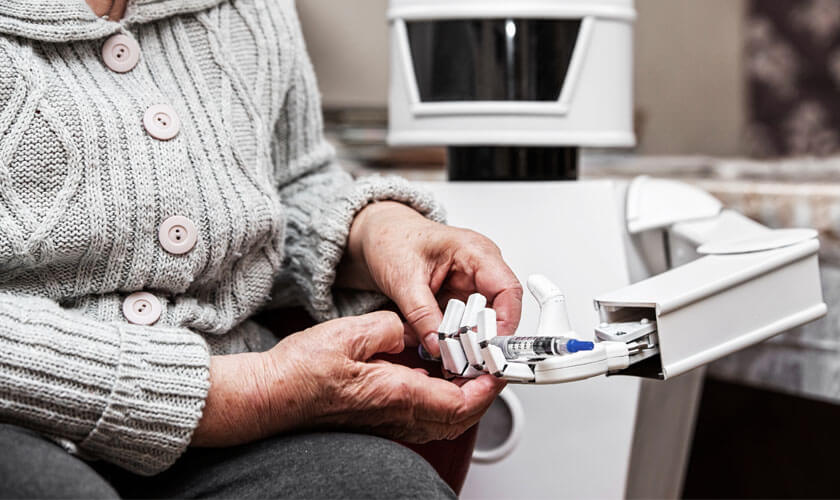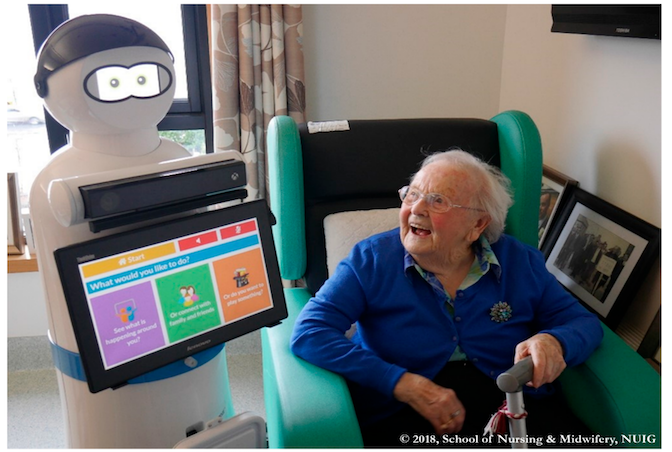
The interaction between humans and artificially intelligent (AI) agents has become increasingly sophisticated in recent years. While AI capabilities are still far from the abilities depicted in science fiction movies, those gains have nevertheless been significant.
Speech recognition, speech production and the ability of AI to engage humans in dialogue have become more effective. Emotional recognition from facial expressions and speech is becoming more accurate, and physical movement by artificial agents in natural environments has become considerably more adaptive. It is becoming increasingly possible for us to engage with more and more sophisticated artificial social agents in our everyday lives, whether they are embodied as robots or purely digital in nature.
A particularly controversial domain in which the potential use of artificial agents has been discussed is care. There is a continuously worsening shortage of care workers for a steadily increasing number of persons in need of care, especially in the care for older persons and persons with disabilities. Care work is highly demanding, and the toll on professional and family carers has become even more pronounced since the onset of the COVID-19 pandemic. The potential benefit of having additional tools for non-human care provision became particularly evident during the early days of the pandemic, where human contact in residential settings became severely limited due to infection control measures and vulnerable care recipients were often left without comfort, interaction or stimulating experiences. It has been proposed that the use of artificial agents to perform some care tasks might help improve care by adding new care experiences and take pressure off overstretched carers.

Social robots in particular have been proposed for a variety of care tasks in institutional and home settings. Due to being embodied, their attempts at interaction easily draw users’ attention and they are experienced as emotionally engaging, even for users unfamiliar with technology. Social robots are designed to fulfil different functions, most frequently companionship, entertainment, assistance, and learning, with their appearance adapted to these tasks. For example, a pet robot like Paro is small and covered in soft fur. It is a companion that responds to the user, entertains them, and allows them to take care of it, thereby counteracting feelings of loneliness.
The robot MARIO that was developed for users with dementia in an EU project coordinated by Prof Dympna Casey in Nursing at NUI Galway, is a human-shaped, 1.20m tall assistive robot that is able to navigate the environment and communicate both by voice and a tablet interface. Its purpose is providing personalised support to help users manage their daily life, provide reminders, engage them in music, games or therapeutically beneficial activities like reminiscence, and connect them with others.
The highly versatile humanoid robot NAO is often used for entertainment or instruction, for example, for engaging users in games, physical movement or learning activities. One application area is their use for children with autism, helping them learn letters or body parts, imitate movements, or practise social interaction when they find this difficult with human interlocutors. The baby simulator robot RealCareBaby, a natural looking baby robot, is used in a variety of ways, as companion for some, as baby care training device for others, and as a means of assessment of a person’s basic infant care skills. These robots can engage and support users, with availability around the clock.
However, the use of robots in care has not been uniformly welcome; some people worry that robots might negatively impact care. Popular culture has depicted benefits and concerns associated with the use of general-purpose care robots, for example in the movie “Robot & Frank” or the recent Channel 4 series “Humans”, which depict the potential complexity of relationships between humans and care robots. While these films provide very perceptive and complex depictions of ethical concerns, the abilities of currently available robots are still a far cry from those fictional robots.

Currently, a crucial concern is that robots may simply not be very good at their tasks, especially when they are required to manage unstructured environments or interpret complex social clues. A robot with limited abilities, or with abilities that are misunderstood by those deploying them, may be more harmful than beneficial if used in the wrong way and without competent human supervision. For example, persons with language difficulties, such as older persons with dementia, stroke survivors or children with autism may not be able to interact with ordinary speech interfaces, potentially resulting in ineffective or distressing interactions. Even when fulfilling their functions as designed, robots may be perceived as not very helpful by the intended users and carers, especially after the initial novelty has worn off. This has been shown to occur regularly in care settings where robots have been introduced, even for robots where research has repeatedly shown positive impact.
Some people are worried that using robots for care may replace genuine human empathy with a mere simulation of care. For example, Sherry Turkle, a researcher from MIT, worries about what happens to us psychologically when we engage with robots instead of engaging in authentic mutual relationships that she sees as essential for our psychological well-being. Given that robots are carefully designed to please us, she is concerned that we might perhaps come to like interacting with robots more than is good for us. Shannon Vallor, a robot ethicist, has argued that replacing human care by robot care may also be bad for those who delegate their care tasks to robots. If robots become widely accepted, care systems may be tempted to rely increasingly on robots, especially for persons who have challenging needs and with whom carers might find it difficult to engage. There is a risk that they may use robots to avoid enhancing their empathy and sensitivity and confronting how vulnerable human life is.

Given these challenges, it is essential that the introduction of robots into care setting be monitored carefully and be accompanied with appropriate training for care staff and managers. The Erasmus+ PROSPERO project, a cross-European project coordinated through IT Sligo that involved several researchers from NUI Galway, has looked at training needs of care professionals for the use of social robots in care.
While care staff do not need to acquire complex technical knowledge, they need to have a basic understanding of robots as information processing devices and understand how to ascertain their potential and limitations for the specific care setting. A core message of the project is that current social robots need to be realistically understood as highly specific tools for certain care tasks, rather than the all-purpose, autonomously operating devices depicted in popular culture. Their use requires human carers who are familiar with the setting and the intended users and potential robot uses to carefully plan suitable robot-supports for specific care needs. They also need to sensitively prepare users and family carers for the use of this technology. As the use of social robots and AI becomes more common in care, the inclusion of training on such devices in the education of care professionals is likely to become increasingly important.
Profiles

Heike Felzmann is a Senior Lecturer in Ethics in the School of History and Philosophy at NUI Galway. Her work focuses on the exploration of ethical issues in the fields of health and information technology. She has contributed to several European projects on healthcare robotics, including H2020 MARIO, ERASMUS+ PROSPERO, and COST Wearable Robots.